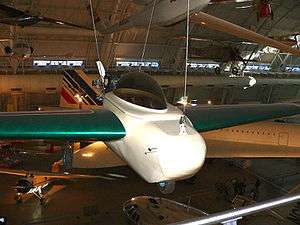Mitchell U-2 Superwing
The Mitchell U-2 Superwing is an American tailless ultralight aircraft that was designed by Don Mitchell for amateur construction.[1]
| Mitchell U-2 Superwing | |
|---|---|
 | |
| A Mitchell U-2 superwing at the Steven F. Udvar-Hazy Center | |
| Role | Ultralight aircraft |
| National origin | United States |
| Manufacturer | Mitchell Wing Company |
| Designer | Don Mitchell |
| First flight | 1980 |
| Status | Plans available |
| Unit cost |
$5500 US average materials cost + instruments & engine |
| Variants | AmeriPlanes Mitchell Wing A-10 |
Design and development
Although the aircraft was designed before the US FAR 103 Ultralight Vehicles rules came into force, the U-2 Superwing complies with them anyway (including the category's maximum empty weight of 254 lb (115 kg)). The aircraft has a standard empty weight of 240 lb (109 kg). It features a cantilever mid-wing, a single-seat enclosed cockpit, tricycle landing gear and a single engine in pusher configuration. The U-2 is a development of the high-wing B-10.[1]
The aircraft fuselage is made from welded steel tube, while the wing is of wood and foam, with doped aircraft fabric covering. Its 34 ft (10.4 m) span wing employs a modified Wortmann FX05-191 airfoil. The flight controls are unconventional; pitch and roll are controlled by elevons and yaw is controlled by the wing tip rudders. The main landing gear has suspension and the nose wheel is steerable and equipped with a brake.[1][2]
The U-2 can accept a variety of engines ranging from 25 to 40 hp (19 to 30 kW) mounted in pusher configuration.[3]
Specifications (U-2)
Data from Cliche[1]
General characteristics
- Crew: one
- Wingspan: 34 ft (10 m)
- Wing area: 136 sq ft (12.6 m2)
- Empty weight: 240 lb (109 kg)
- Gross weight: 550 lb (249 kg)
- Fuel capacity: 3 U.S. gallons (11 L; 2.5 imp gal)
- Powerplant: 1 × Zenoah G25 , 20 hp (15 kW)
Performance
- Stall speed: 26 mph (42 km/h, 23 kn)
- Range: 180 mi (290 km, 160 nmi)
- Maximum glide ratio: 20:1 at 45 mph (72 km/h)
- Rate of climb: 400 ft/min (2.0 m/s)
- Wing loading: 4.04 lb/sq ft (19.7 kg/m2)
See also
Aircraft of comparable role, configuration and era
References
- Cliche, Andre: Ultralight Aircraft Shopper's Guide 8th Edition, page E-259. Cybair Limited Publishing, 2001. ISBN 0-9680628-1-4
- Lednicer, David (2010). "The Incomplete Guide to Airfoil Usage". Archived from the original on 20 April 2010. Retrieved 1 September 2011.
- Bayerl, Robby; Martin Berkemeier; et al: World Directory of Leisure Aviation 2011-12, page 137. WDLA UK, Lancaster UK, 2011. ISSN 1368-485X
External links
| Wikimedia Commons has media related to Mitchell U-2 Superwing. |
- US Pacific; Current supplier of Mitchell Wing plans
- AmeriPlanes former manufacturer of Mitchell Wing kits - website archives on Archive.org